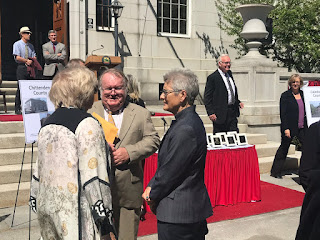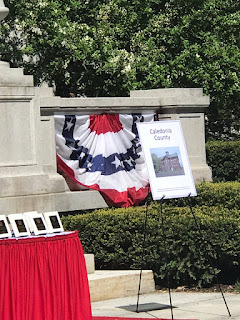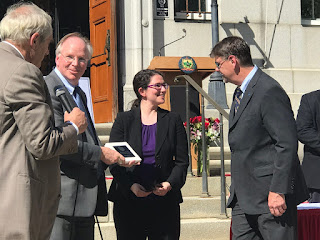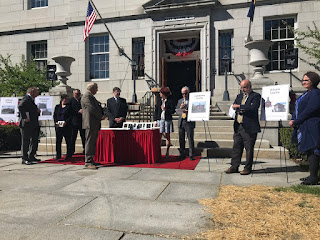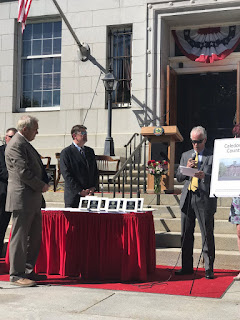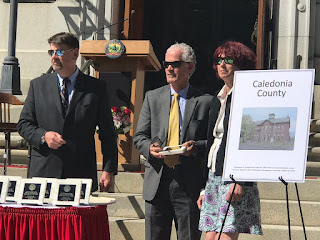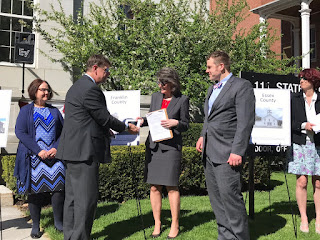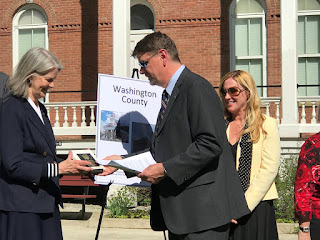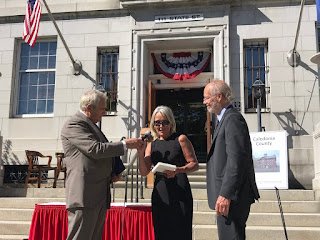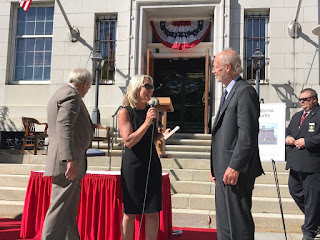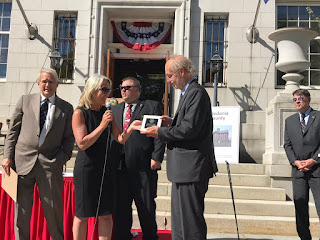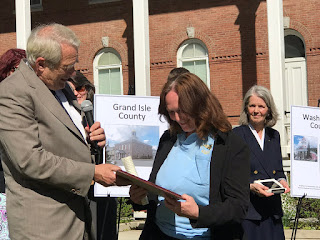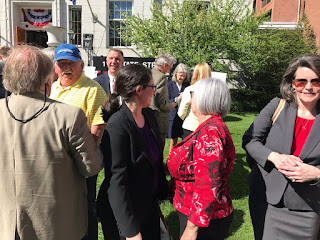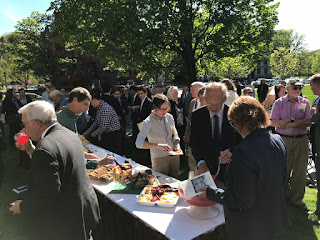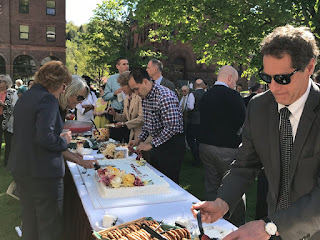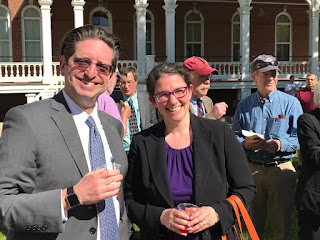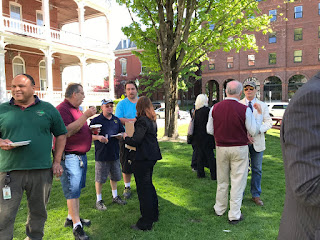On the 100-year anniversary of the Vermont Supreme Court Building, many gathered on the front lawn of the Supreme Court on Friday afternoon to celebrate the bench and bar’s role in preserving the rule of law. The ceremony was well-attended on what turned out to be an incredibly warm and sunny day.
Chief Justice Paul Reiber conducted the ceremony as emcee, with Governor Phil Scott to speak first after the Chief’s opening remarks. Governor Scott praised judges and lawyers alike for preserving the rule of law and how important the role of the judiciary is, regardless of politics. Governor Scott noted how honored he has been to appoint many judges as well as Justice Carroll, whose appointment gave the Vermont Supreme Court a female majority for the first time in history.
These remarks garnered applause and made a perfect segue for House Judiciary Committee Chairwoman Rep. Maxine Grad to speak next. Representative Grad spoke of the separation of powers, remarking how her work just up the hill is subject to review by the Court, while the Court takes into consideration the legislative intent and will of the people when it interprets the laws just down the hill. It is this separation and review that protects the rule of law.
Before turning the ceremony over to the individual counties, Justice Reiber pointed out the plaque just next to the building commemorating the landmark civil union decision. He also read the remarks sent by Senators Leahy and Sanders, sending their warmest congratulations on 100 years of furthering justice. They remarked how lawyers protect equality among citizens and sent best wishes for the next 100 years of fostering respect for the rule of law.
Justice Reiber spoke next, noting how Supreme Court business was originally conducted rotating hearings among courthouses in shire towns. The ceremony proceeded to go through a brief history of each county, in order of establishment, with VBA President Dan Maguire presenting each county’s presiding judge and County Bar President with a marble plaque, made of marble from the original Court’s construction. Each presiding judge, or designee, read fascinating stories about the birth of their county and its courthouse. More detail for each county and their landmark cases can be found in Paul Gillies’ essay, HERE. First up was Bennington County.
After Vermont departed from being a part of New York’s Albany County, Vermont’s first legislature divided Vermont into two counties: Bennington and Cumberland. The courts first met at the Catamount Tavern in Bennington. The original Supreme Court alternated between the two shires of Bennington and Manchester.
All of the towns in Windham County were part of Cumberland County originally. The Westminster Courthouse was built in 1772, although the court was prevented from opening in 1775 in the Westminster Massacre. Westminster remained the first County shire until the court moved to Newfane.
In 1781, Bennington County was split into two parts, one being Rutland County. Tinmouth was the first shire of Rutland County and the court met at Solomon Bingham’s Public House. Judge Hoar noted the theme of courts meeting in taverns originally, and also noted that the present courthouse was constructed at a cost of only $12,000 in 1871.
While originally Newbury was the shire of Gloucester County and remained the first shire of the newly formed Orange County, Chelsea was named the shire town of Orange in 1796. The first courtroom was built after court was originally held in Heaton’s tavern in Thetford.
After the creation of Windsor County in 1781, the court met regularly but moved from town to town until Woodstock was appointed by the legislature to be the first shire town in 1786. The present courthouse was constructed in 1787 at a cost of $14,000.
In Addison, the court met in private homes and taverns in Addison for several years until the court removed to Middlebury in 1791. The first courthouse was constructed by subscription, funded by the citizens, in 1798.
Addison County was divided in 1787 to create Chittenden County, with court being held at the home of Ira Allen in first shire town of Colchester. Burlington became the shire in 1790 and the first court meeting was at the tavern of Gideon King on Battery Street.
When Caledonia County was formed in 1792, the question of which town would serve as the shire was undecided. Danville and Peacham competed for the honor, and the legislature left the decision to the voters in the town who would bear the cost of the county buildings. Peacham decided against the expense, and Danville was chosen in 1796.
Orleans County was formed in 1792 out of northern Orange County. Commencing in 1800, the court opened in Craftsbury and the following year, the court met at Brownington, alternating between the two half-shires until 1816, when Irasburgh had completed a courthouse and jail to become the sole shire of Orleans County. In 1886, the courts were transferred to Newport, the new shire, due to its railroad access.
Franklin was carved out of northern Chittenden County in 1792. The present courthouse was completed in 1879 at a cost of $50,000. Like Orleans, Essex was also carved out of northern Orange County in 1792. Lunenburgh and Brunswick were half-shires of Essex until Guildhall was made shire in 1802, with the courthouse built on donated land but with construction funded by a property tax. Grand-Isle was established in 1802, carved out of Franklin County. The first court session was held in 1806 at a hotel ballroom in North Hero, and the courthouse was completed in 1824.
Montpelier became the Capital City in 1808 and two years later became the shire town of Jefferson County, newly formed from parts of Orange, Addison, Chittenden, and Caledonia counties. In 1810, as a direct response to the embargo, Jefferson County was renamed Washington County. At first, the court met at the State House, then in a courthouse on the Capitol grounds. The present courthouse was constructed in 1880.
Lamoille County was the last county to be formed in Vermont, in 1836, out of towns from Chittenden, Franklin, Washington, and Orleans Counties, at the same time as the Vermont Senate was established. The idea was a county that was neither east nor west, and arguably wouldn’t side with one region or the other. The Hyde Park Courthouse, opened in 1918 and recently renovated, stands in the center of the village.
After all the county judges and bar representatives gave their brief county histories and received their plaques, Chief Justice Reiber returned to the podium to praise all the courts for all their hard work and dedication to serving justice for the past 240 years. He then called up Paul Gillies, and the Chief and VBA Executive Director Teri Corsones gave Paul Gillies a commemorative plaque showing appreciation for Paul’s contributions to the ceremony, including researching the county histories, writing the commemorative essay, preparing the trial re-enactment and materials and acting as general historian for the event. Justice Reiber then gave Jean Crockett a plaque as a thank you to Jean and all of the Building and Grounds Services for their help with preparing the building and grounds for the event.
Everyone was invited to attend the re-enactment of the oral argument of Dodge Brothers v. Central Vermont Railway, one of the cases heard in 1918 on the first day that 111 State Street was first used by the Vermont Supreme Court. Of course, no event is complete without refreshments and the Court and VBA delivered with a variety of food items, refreshing punch and, as always, an amazingly large and delicious commemorative cake made by VBA’s own Teri Corsones.
Please enjoy all the pictures from the event, below. The video recording of the entire ceremony is HERE.







